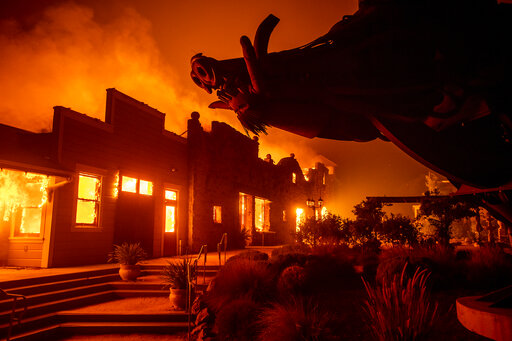PG&E Corp. is trying to determine whether other jumper cables along its system may be susceptible to failure after one broke in October, minutes before the massive Kincade wildfire ignited in Northern California wine country.
PG&E said it was looking into whether the configuration of a jumper cable on a transmission line near the Kincade Fire’s ignition point contributed to its failure, and whether similar risks exist elsewhere, according to a written response Friday to questions raised by a federal judge overseeing the company’s probation.
The company said the California Department of Forestry & Fire Protection has collected the failed jumper cable as evidence in its probe of the cause of the Kincade fire, which burned for two weeks starting Oct. 23 and destroyed 374 structures. A jumper cable is used to connect high-voltage transmission lines on PG&E’s power network.
A loose PG&E jumper wire was found to have contributed to last year’s Camp Fire — the deadliest in California history — which killed 86 people and destroyed the town of Paradise. In addition to that blaze, PG&E’s equipment has been tied to other wildfires that devastated parts of northern California in 2017 and 2018, saddling the company with an estimated $30 billion in liabilities and forcing it into bankruptcy.
To prevent a repeat during California’s peak fire season, the utility orchestrated a series of mass blackouts to prevent its lines from sparking blazes.
PG&E said it has identified at least 190 instances in late October in which contact between vegetation and power lines on windy days probably would have caused electric hazards if the lines hadn’t been de-energized. The company also counted at least 28 places where infrastructure that it suspected was damaged by extreme wind probably would have caused arcing if the power hadn’t been shut off.
U.S. District Judge William Alsup, who is overseeing the company’s probation after it was convicted in 2016 of gas pipeline safety violations, is trying to determine whether PG&E’s equipment is to blame for any of this year’s wildfires in Northern California, as well as how the state’s largest utility managed widespread power outages as a fire prevention measure.
Besides asking several questions about jumper cables, Alsup requested detailed information about PG&E’s preventative blackouts.
Given the utility’s widespread shutoffs, Alsup said he’s inclined to think damages and deaths are lower this year, “but the court (and the public) would appreciate a more precise answer.”
No known fatalities have occurred this year in fires tied to PG&E’s lines. PG&E said no
structures have been destroyed by fires of ten acres or more tied to its distribution lines. PG&E did note that three structures were destroyed by fires one acre or less that were connected to its lines.
The utility has said it switched off lower-voltage distribution lines before the Kincade fire broke out, in anticipation of high winds, but the company kept larger transmission lines energized. PG&E Chief Executive Officer Bill Johnson has said the jumper cable — along a transmission line — had been recently inspected and was in good condition.
PG&E told the court that it had used the wrong form to document a drone inspection of the suspected equipment in May and marked the condition of the jumper as “n/a.” In February, the utility found that the jumper wasn’t in poor condition during a climbing inspection, it said. PG&E said a worker performed a visual inspection of the suspect tower and jumper cables in July and found no new issues.
The case is U.S. v. Pacific Gas and Electric Co., 14-0175, U.S. District Court, Northern District of California (San Francisco).
About the photo: Flames from the Kincade Fire consume Soda Rock Winery on Sunday, Oct 27, 2019, in Healdsburg, Calif. (AP Photo/Noah Berger)
Was this article valuable?
Here are more articles you may enjoy.


 California Bill Would Require Insurer Claims Handling Plans, And Double Penalties
California Bill Would Require Insurer Claims Handling Plans, And Double Penalties  OpenAI And Microsoft Sued Over Murder-Suicide Blamed on ChatGPT
OpenAI And Microsoft Sued Over Murder-Suicide Blamed on ChatGPT  Billionaire NFL Owner Suing Over Billboards Near His SoFi Stadium
Billionaire NFL Owner Suing Over Billboards Near His SoFi Stadium  Cyber Breach Affected 750,000 Canadian Investors, Regulator Says
Cyber Breach Affected 750,000 Canadian Investors, Regulator Says 